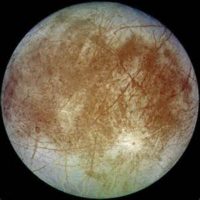By Sammie Jones-
NASA has announced that, Hubble Telescope has discovered evidence of possible water plumes on the freezing moon- one of Jupiter’s largest. Where there is water there is usually life.
They also evidence of some surface water on its icy surfaces and added that they also had found evidence of a sea on another of the gas giant’s smaller moons, called Enceladus.
The mind blowing dual announcement will be seen by many as possible confirmation that alien life exists in our solar system. however NASA have tweeted: they insist aliens have not been found on Europa.
However Ufologists will be exited because of the increased chance this water could be home to alien life forms, the planned manned mission may be required to confirm this. In 2015 NASA scientists were urged to consider examine how a potential mission to Jupiter’s small icy moon could search for signs of alien life.
Paul Hertz, director of the Astrophysics Division at NASA Headquarters in Washington, said: “For a long time humanity has been wondering whether there’s life beyond earth and we’re lucky to live in an era where we can address questions like that scientifically.
“On earth, life is found wherever there is energy, water and nutrients, so we are interested in anywhere which shares these characteristics. Europa might be such a place.”
He added: “Today’s events increases our confidence that water and other materials from Europa’s hidden ocean might be on the surface of Europa and able for us to land and study without digging through those miles of ice.”
Europa is believed to have such an extensive ocean that great tides beneath the ice regularly bring seawater close to the surface of the moon.
HYPOTHESIS
A wide range of hypotheses for water on Europa, and how that would actually ascend, was projected by scientists, who concluded that there are still lots of questions left unanswered for future missions.
The discovery was made by an ultra-violent camera on the Hubble Telescope which was only available to researchers after astronauts performed a daring space -walk to repair it in 2009.
Jennifer Wiseman, senior Hubble project scientist at NASA’s Goddard Space Flight Center in Greenbelt, Maryland, said: “We’re thrilled about these findings. Because of that heroic repair we are achieving amazing science advances like this.”
At the same astonishing conference call NASA scientists also revealed some results of their survey that one of Jupiter’s smaller moons, Enceladus, which revealed it too could have a “global ocean”.
Space enthusiasts and ufologists went into a frenzy last week when NASA declared that it would be holding a conference to reveal ‘surprising activity’ on Europa – arguably the most well known of Jupiter’s 67 moons.
The teleconference among senior NASA officials occurred at 7 pm BST.
Announcing the event, NASA representatives stated : “Astronomers will present results from a unique Europa observing campaign that resulted in surprising evidence of activity that may be related to the presence of a subsurface ocean on Europa.”
The universe is governed by the rule that evidence of water and oxygen, indicates evidence of life, at least theoretically.
This spectacular view looks down on Saturn’s northern regions, with its pole still in the darkness of the northern hemisphere winter. The rings cast a band of shadow across the gas giant world
Jupiter’s largest moon Ganymede, seen here on the right, is the ninth largest object in the solar system and is bigger than the planet Mercury.

